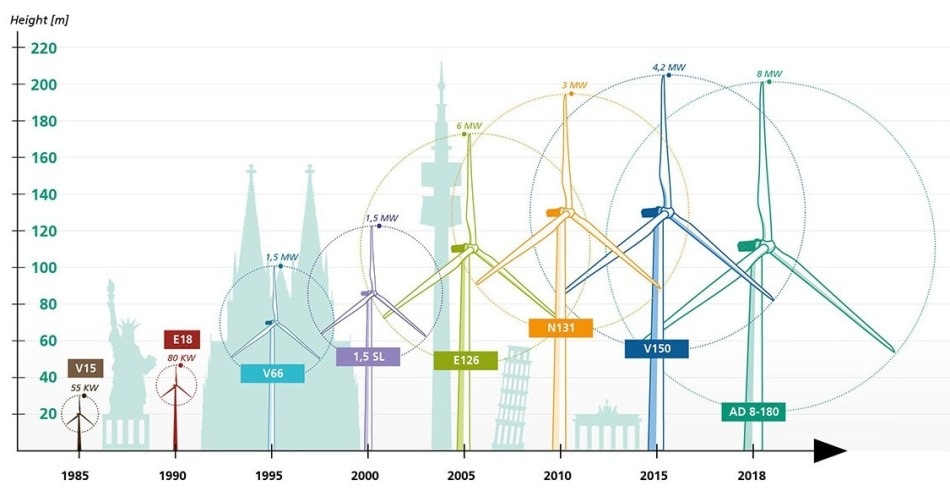Aug 14 2019
In the last four decades, the successful adaptation of technology for offshore use and cold climates and enhanced techniques for predicting wind conditions have stimulated a considerable increase in the use of wind turbines for generating electricity. A new study assesses the present status and future prospects of this field.
 Growth in wind energy solutions sees larger, more efficient wind turbines over the decades. (Image credit: Fraunhofer IWES)
Growth in wind energy solutions sees larger, more efficient wind turbines over the decades. (Image credit: Fraunhofer IWES)
A group of scientists from Germany has reported its findings in Applied Physics Reviews, from AIP Publishing, studying the advancement of wind technology as a renewable energy source and evaluating its viability for continuously acquiring larger shares of the electricity market.
The study points toward remarkable advancements in the technology, partly due to economies of scale, and predicts even larger, more cost-effective turbines in the future.
The size of a state-of-the-art turbine is extremely impressive. The swept area of the rotor of a standard turbine is now twice the size of a football field. In parallel to the development in size, the technology has also become mature, meaning cost-effective and reliable.
Berthold Hahn, Study Author
From the 1970s, there has been progress in wind turbines to produce at least 100 times more power than their forerunners. Existing large turbines have the capacities to produce around 5 MW. Hahn stated that market estimations for future turbine capacity reach up to 10–15 megawatts. The rotor diameters of a few of these larger turbines could be as long as 200 m.
At this time, the cost to generate electricity from wind has dropped from $500 per megawatt-hour to $50.
“The technical developments, like floating offshore turbines enabling the harvest of wind energy in very deep waters, integrated control strategies considering the needs of the grid, and artificial intelligence permanently assessing the performance of the turbines, have contributed to the impressive cost reductions,” stated Hahn.
Yet, the wind power industry experiences constant pressure to decrease costs. The study pinpointed an important area, finding more cost-effective means for turbine maintenance. Research that combines historical maintenance data and real-time measurements from turbines is required for the early detection of turbine failures.
With enhancements to other parts of the power grid such as power storage, Hahn predicts wind technology could become vital for meeting the electricity supply and demand volatility that markets face.
“In many countries, wind energy has started to take over tasks of stabilizing the grid from large conventional plants, meaning that the energy systems are now eventually changing from a mainly centralized structure to a decentralized one,” he stated.